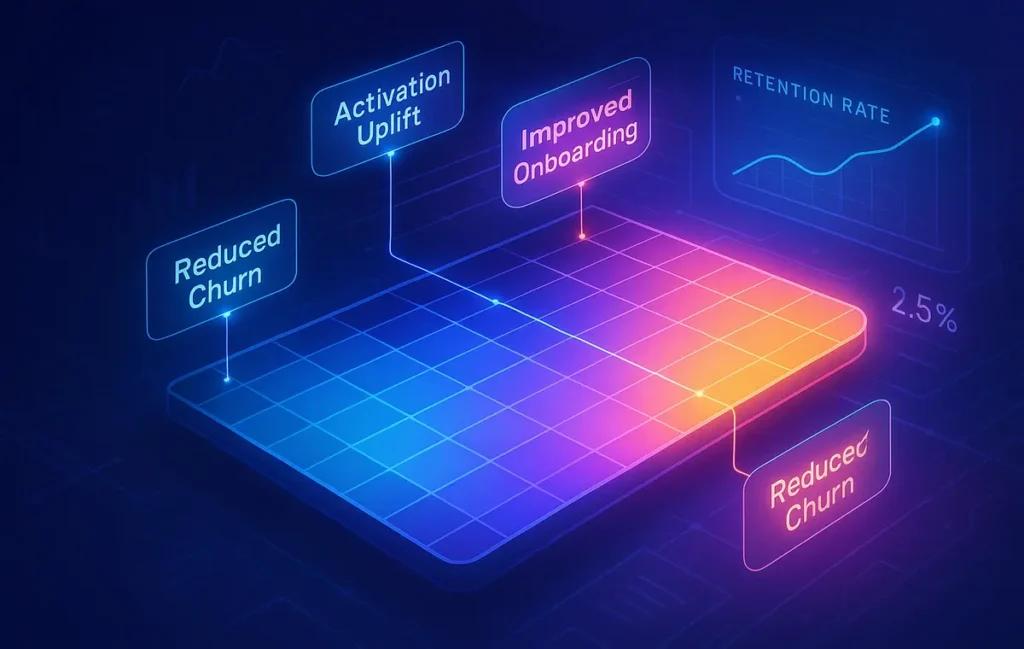🧮 Intro
Everyone loves talking about acquisition. New channels, creative tests, CPC hacks. But here’s the truth serious operators already live by: retention is growth. Without a system that keeps customers coming back, your best-performing ad set is just pouring water into a leaky bucket. Churn quietly taxes every campaign and compounds over time. Reduce it by a few points and the effect ripples through revenue, CAC payback, and product velocity.
In this guide, NerdChips lays out a retention playbook you can actually run. We’ll define the core metrics, translate them into decisions, and show you how to build a data-backed cadence that detects churn risk early and intervenes before it’s too late. Along the way, we’ll connect the dots to your stack—analytics, CRM, lifecycle automation, and team execution—so you’re not stuck in “insight theater.” If you’re choosing tools, don’t miss our deep dives on SaaS Analytics Software for Startups and a practical comparison of CRM vs. Marketing Automation; both are essential to make these tactics stick.
💡 Nerd Tip: Before chasing “advanced” tactics, instrument the basics so well that your weekly retention snapshot fits on one page. Clarity beats complexity.
📈 Why Retention Matters (More Than You Think)
If new customers are expensive—and they are—then the fastest path to durable growth is protecting the revenue you already worked to win. In most subscription businesses, acquiring a new customer costs 5–7× more than keeping one, and even small retention gains compound like crazy. A modest 5% improvement in monthly retention cascades through higher LTV, steadier cash flow, and larger budgets for product and brand.
Retention also clarifies product truth. Acquisition can be “gamed” with compelling offers and landing pages; retention can’t. When cohorts stabilize, it means the product is doing a job well enough for people to make it part of their routine. That’s when NPS and advocacy rise, CAC payback shortens, and forecasts stop feeling like fan fiction.
Finally, retention reduces operational chaos. It smooths revenue volatility, which makes planning sane and gives your team more cycle time to ship features customers actually want. In other words, retention buys you time—the scarcest resource in any startup. For practical tool choices, see our roundup of Affordable Analytics Tools for Small Businesses; you don’t need a giant budget to start measuring what matters.
💡 Nerd Tip: Speak finance’s language. Tie retention to LTV/CAC and gross margin so your roadmap wins resources without political fights.
🧮 Key Metrics to Track (and How to Use Them)
The problem with “track everything” is you end up using nothing. Keep it tight: a handful of metrics that map directly to decisions.
Churn Rate (Gross vs. Net). Gross churn measures the percentage of customers (or MRR) you lose in a period. Net churn incorporates expansion revenue; if it’s negative, expansion beats attrition—a magical place to be. Use gross to diagnose product-market fit and net to budget growth.
Customer Lifetime Value (CLV or LTV). Not a theoretical number—make it a living metric. Tie it to real cohort behavior and your current gross margins, and update quarterly. LTV tells you what you can spend to acquire (and save) a customer.
Activation Rate. The strongest leading indicator of retention. Define a crisp, behavior-based “aha” milestone (e.g., “created first report and invited a teammate”). If activation is weak, no lifecycle campaign can save you at scale.
Usage Frequency & Depth. Logins alone are vanity. Define critical actions per period (queries run, tasks completed, files processed) and watch medians and distributions, not just averages.
Cohort Retention. Look at week 1/4/12 or month 1/3/6 active rates by signup cohort. Stable horizontal bands tell you who is sticking. Divergence by segment tells you where to intervene.
NPS / CSAT + Qual Themes. Numbers without words mislead. Track open-text reasons for promoters/detractors and map them to product areas.
Quick Reference Table
| Metric | Why it matters | Action trigger |
|---|---|---|
| Gross churn | PMF health | >3% monthly? Investigate activation & usage drops |
| Net churn | Budget & growth | Positive? Push expansion playbooks |
| Activation rate | Predicts retention | <60%? Fix onboarding before lifecycle emails |
| Weekly active + depth | Detects decay | 2-week slide? Trigger re-engagement flows |
| Cohort curves | See true stickiness | Flattening early? Revisit value prop & pricing |
💡 Nerd Tip: Put Activation, Week-4 Retention, and Net Churn on the top row of your weekly exec dashboard. If those move in the right direction, most other “nice-to-haves” follow.
🛟 Want to Cut Churn Before It Spikes?
Instrument activation, add early-warning triggers, and centralize “save” actions. Try Mixpanel or Amplitude for cohorts, pair with Baremetrics for subscription truth, and wire playbooks in your CRM.
🧪 Pro Tips to Reduce Churn (Data-Driven and Runnable)
1) Segment Like a Scientist, Not a Tourist
Start with behavior-based cohorts in Mixpanel or Amplitude: platform (web/mobile), primary job-to-be-done, company size, plan tier, and integration footprint. You’ll notice patterns: users who connect two integrations within the first 48 hours often retain 2–3× better; accounts with two or more collaborators churn less than solo accounts. That’s not trivia—those are levers. Design onboarding to push new users toward the high-retention behaviors (e.g., one-click integration gallery, teammate invite prompts, prebuilt templates by job-to-be-done). Pair this with CRM fields so success managers see risk at a glance; our guide on CRM vs. Marketing Automation explains where to store what.
“The day we stopped segmenting by vanity demographics and started segmenting by first-week actions, our churn line finally bent,” — a product lead on X.
2) Track Early-Warning Signals (EWS) and Trigger Help
Churn rarely occurs in a single moment; it’s a drift. Define EWS thresholds per segment, such as 30–40% week-over-week drop in critical actions, no usage for 7 days, or failure to complete the key setup step. Route these signals to lifecycle automation and humans: send a personalized nudge, surface a contextual checklist, or open a light-touch success task. If you use a task platform, connect triggers to your team’s board—our favorites are in Best Task Management Software for Teams.
3) Personalize Outreach with Behavior, Not Guesswork
Generic “we miss you” emails are easy to ignore. Craft messages that mirror what the user tried to do and why it mattered. If someone started an integration but didn’t finish, send a 30-second video or a one-click magic link to complete it. If they ran out of credits, suggest the smallest plan that meets observed usage. Make support a selling point—fast, specific, and kind.
4) Fix Onboarding Like It’s the Only Growth You Have
Most churn is born in the first week. Map the funnel from signup to activation, then remove friction ruthlessly: pre-fill fields, defer non-critical questions, add opinionated defaults. Use session replays (Hotjar/FullStory) to see where users hesitate or rage-click. If one step causes 40% of drop-offs, that step isn’t a step—it’s a wall. Replace with a progressive wizard or backstage setup that runs while the user keeps moving.
5) Win-Backs that Respect Time and Pride
Churned users aren’t enemies; they are shoppers who didn’t find enough value. Make your win-back cycle helpful: a short “what changed since you left” update, a data export reminder, and a low-friction reactivation offer. Segment win-backs by reason-for-churn if you can (price, missing feature, complexity). Time them to when the original job-to-be-done resurfaces (e.g., month-end reporting).
6) Predictive Analytics (Start Simple, Get Useful)
You don’t need a PhD to spot risk. Begin with logistic regression or simple scoring: assign points to risk signals (inactivity, low depth, no integrations, solo user). Accounts crossing a threshold land in a “save” queue. As you scale, use built-in ML in analytics platforms to score churn probability and trigger playbooks automatically. Keep models interpretable; if success teams don’t trust the scores, they won’t act.
💡 Nerd Tip: Tie save actions to dollar outcomes. If a CSM’s outreach prevents churn on a $120 MRR customer and it takes 10 minutes, you just paid for that role many times over. Make the math visible.
🧰 Tools That Help (and Where Each Shines)
Mixpanel / Amplitude — Behavioral Analytics & Cohorts. Use them to define activation, map funnels, and monitor weekly retention by cohort. Their alerting and cohorts-to-destinations connectors let you push segments into email, ads, or your CRM. For startups, see SaaS Analytics Software for Startups for a pragmatic setup that doesn’t eat your week.
Baremetrics / ChartMogul — Subscription Truth. This is where MRR, ARR, expansion, and churn live without spreadsheet chaos. Pipe Stripe/Chargebee data in, tag cancellations by reason, and analyze cash impact. If your net revenue retention is a mystery, you’re flying without instruments.
HubSpot (or your CRM of choice) — Lifecycle & Playbooks. Store relationship context and orchestrate outreach. Build pipelines for risk accounts and playbooks for specific triggers (no usage, stuck in onboarding). Our primer on CRM vs. Marketing Automation helps you keep logic in the right place.
Hotjar / FullStory — Experience Reality. Numbers show what, replays show why. Use replays to prioritize UX fixes, not as a surveillance theater. A single friction fix can beat a month of “engagement campaigns.”
Retool or your favorite internal tools platform — Operational Glue. Stitch analytics, CRM, and billing into a “Save Desk” that surfaces risk, context, and one-click actions. Your team moves faster when everything they need is on one screen.
💡 Nerd Tip: Your stack is only as strong as your shared IDs. If analytics, CRM, billing, and support can’t agree on who a user is, your “single view of customer” is fiction.
🧩 Implementation Playbook (30/60/90 Days)
Days 1–30: Instrument & Observe.
Define conversion and activation events, wire Mixpanel/Amplitude, connect billing to Baremetrics/ChartMogul, turn on session replay. In your CRM, create fields for activation status, integration count, and last critical action. Build a one-page dashboard: Activation, Week-4 Retention, Gross/Net Churn, and a chart of top churn reasons. Publish it weekly.
Days 31–60: Intervene & Learn.
Add three EWS triggers (e.g., no usage in 7 days, 40% drop in key actions, failed integration) and pair each with an automated nudge and a human follow-up. Fix the top onboarding wall you found in replays. Launch a “teammate invite” nudge if collaboration predicts retention.
Days 61–90: Systematize & Scale.
Codify CSM playbooks with time-to-contact SLAs by MRR band. Build a simple churn-score and route high-risk accounts to a “Save Desk” built in Retool. Launch a respectful win-back series for churned cohorts. Now invest in experiments: pricing nudges for annual plans, product tours that show users their “next best action,” and small features that erase common detractor themes.
“Our churn didn’t budge until we put one owner over activation + onboarding. Ten weeks later, W4 retention was up 9 points,” — a growth lead on X.
💡 Nerd Tip: Promote operators who reduce churn, not just those who drive signups. What you celebrate becomes your culture.
🧮 The Money Math: How a 1-Point Churn Drop Pays for Itself
Imagine $100k MRR, 5% monthly gross churn, and ARPU of $50. You lose $5k MRR each month. Drop churn to 4% and you lose $4k—a $1k monthly delta. That’s $12k a year without counting compounding effects from better expansion and referrals. If a CSM + tooling cost $6k/month and they drive an ongoing 1–2 point reduction, you’re net ahead very quickly—and your pipeline becomes more predictable. Make this math a slide you revisit each quarter to keep leadership aligned.
💡 Nerd Tip: Tie feature bets to retention math. “We think adding SSO for Pro plans will raise W8 retention by 2 points in this segment, worth ~$X MRR per quarter.” It beats arguing aesthetics.
🧯 Challenges & Fixes (So You Don’t Stall)
Incomplete Data. If product, billing, and support don’t connect, insights will contradict. Start with a minimal viable data model: user ID, account ID, plan, activation status, last critical action, MRR. Add slowly.
No Data Culture. Great dashboards go unread without rituals. Establish a Wednesday Retention Review: 30 minutes, same metrics, same room, same decisions. Define two actions per week and track follow-through.
External Churn Pressure. Macro headwinds are real. Focus on what’s in your control: better onboarding, explicit value communication, annual plans with fair discounts, and loyalty perks. If customers must pause, make reactivation easy and dignified.
Feature Thrash. Shipping more doesn’t retain more. Shipping the right friction fix does. Use replays and detractor themes to choose.
Over-Automation. Automation without empathy becomes noise. Keep messages short, helpful, and context-aware. Offer a human path at high MRR bands.
💡 Nerd Tip: Add a “save reason” dropdown for wins. You’ll quickly learn which interventions pay: fast support, integration help, discount, or new feature. Fund accordingly.
🔗 Inline Guides You’ll Use Next
-
If you’re choosing your instrumentation stack, start with our field notes in SaaS Analytics Software for Startups.
-
Clarify systems of record with CRM vs. Marketing Automation so events and messages live in the right place.
-
If budget is tight, pick from Affordable Analytics Tools for Small Businesses and grow as you learn.
-
Convert retention insights into execution with Best Task Management Software for Teams—speed of response saves accounts.
-
Layer productivity habits that reinforce retention work with AI-Powered Productivity Hacks.
Want Field-Tested Retention Playbooks?
Join our free newsletter for step-by-step dashboards, cohort teardowns, and save-desk workflows—delivered weekly by NerdChips.
100% privacy. No noise. Just high-signal retention insights.
🧠 Nerd Verdict
Retention optimization is not one tactic; it’s a management system that blends product, data, and empathetic operations. When you define activation clearly, watch cohorts weekly, and respond to risk with context—not spam—you build a business that compounds. From the NerdChips vantage point, the winning teams do three things relentlessly: they instrument reality, they remove friction, and they follow up like pros. Do that for a quarter and your growth graph starts looking less like a roller coaster and more like a staircase.
❓ FAQ: Nerds Ask, We Answer
💬 Would You Bite?
If you had to pick one lever to run for the next 30 days, would you bet on fixing onboarding to raise activation—or early-warning triggers with human follow-up to save at-risk accounts?
Crafted by NerdChips for creators and teams who want their best ideas to travel the world.



